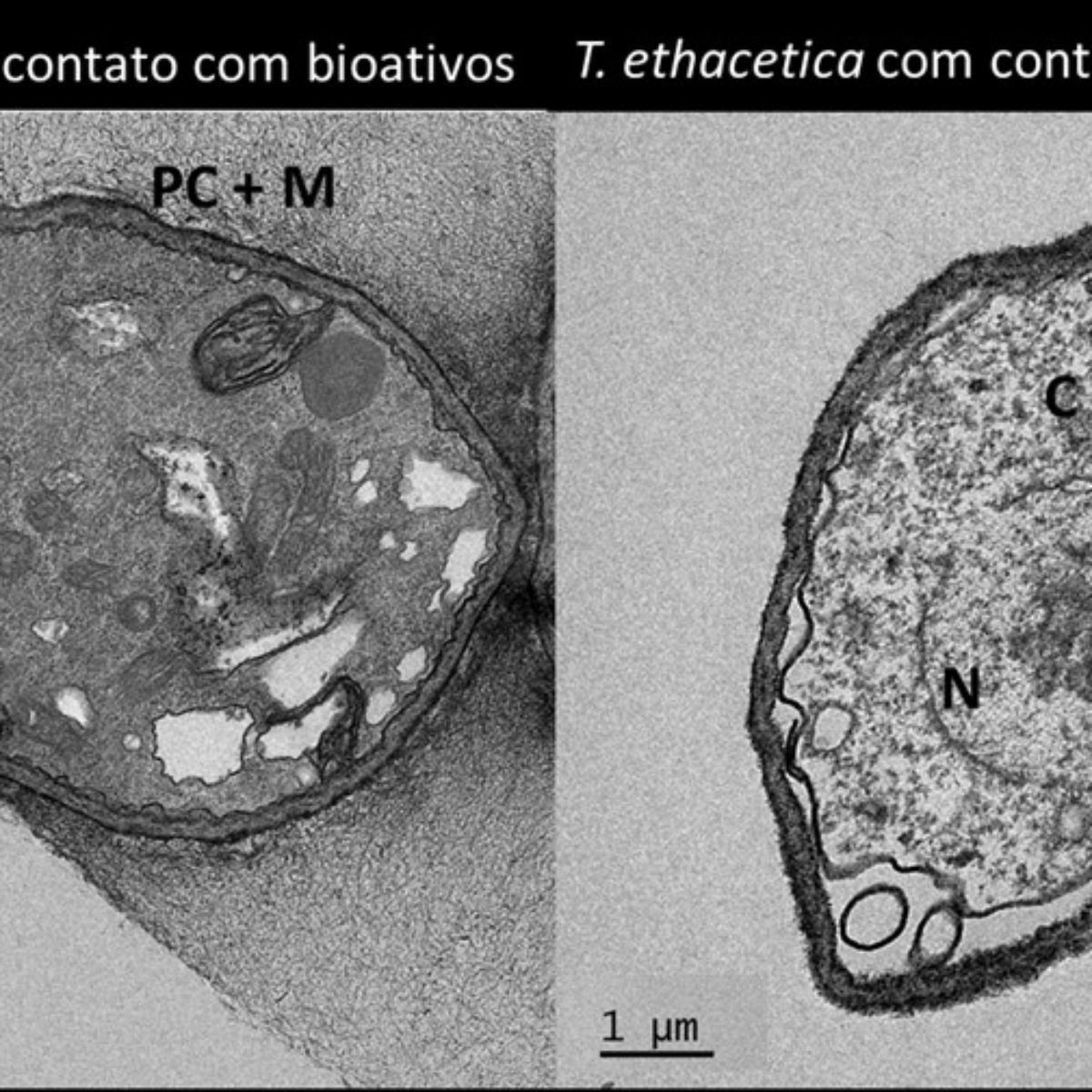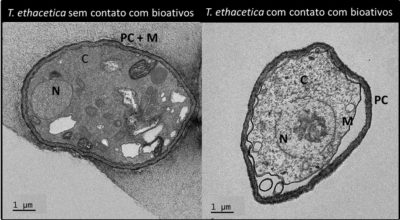
On the left, we see the untreated control fungus, with a preserved cellular structure, with several organelles inside (Nucleus=N, cytoplasm=C, cell wall and membrane=PC + M). On the right, we see the interior of the cell completely degraded, without organelles and with the detachment of the cell wall membrane, culminating in the death of the fungus.
Research paves the way for the development of biological fungicides as an alternative to pesticides used to combat “pineapple sett rot disease”, one of the most frequent pests in sugarcane fields
The “pineapple sett rot” is a disease that affects several tropical crops around the world, but in Brazil it has a particular impact on the productivity of the sugar and ethanol sector. The fungus is capable of preventing seedlings from germinating or delaying their development, leaving the affected areas with large gaps. The microorganism usually penetrates the stem of plants through cuts or injuries caused during planting or mechanized harvesting. The incidence of the disease has increased in recent years and is already among the five most frequent pests of sugarcane.
As the fungus reproduces inside the plant, the stem fibers show an initial reddish color, which gradually becomes darker and covered with spores. The name of the disease is due to the main symptom of the fermentation generated by the fungus, the characteristic odor similar to that of pineapple essence.
Biotechnology has proved to be an important ally to sustainably face deleterious diseases like this, which impact productivity. Through the use of biomolecules, microorganisms and advanced techniques from several areas of engineering, biotechnology works to develop biocompatible alternatives to chemical fungicides, which cause various environmental and human health impacts.
CNPEM researchers have just published an article in the journal Enviromental Microbiology that reveals for the first time molecular mechanisms capable of inhibiting the growth and even causing the death of the fungus Thielaviopsis ethacetica, which causes the “pineapple sett rot disease”. The study is promising for the development of biological fungicides as an alternative to agrochemicals.
There are several management techniques that contribute to disease prevention. From the careful selection of seedlings, care in soil preparation and even the observation of the best conditions of soil, temperature and humidity. However, the most frequent strategy is usually the use of agrochemical fungicides, a resource that depends on imported inputs and can cause serious risks to health and the environment.
The demand for more sustainable agricultural practices motivated biotechnological research in the search for biological alternatives to the use of agrochemicals, mobilized resources and expertise from three CNPEM laboratories and received funding from FAPESP (São Paulo Research Foundation).
The research began by consulting the microorganism bank of the Brazilian Biorenewables National Laboratory (LNBR), which has a collection of about 7,000 bacteria collected in different regions of Brazil. “These microorganisms were isolated, both from the soil and from the roots of agricultural crops. Seventy of them underwent in vitro tests to assess their ability to inhibit the growth of the fungus”, explains researcher Juliana Velasco.
The three bacteria with the best results were selected for further analysis, in which the bioactive compounds responsible for the inhibition were identified. These bacteria prevented up to 80% of the phytopathogen’s micellar growth, and by genetic sequencing they were found to belong to the Pseudomonas genus. When the identified bioactive molecules were tested at different concentrations, a total inhibition of fungal growth and death was observed.
“The gene transcription data of this phytopathogen showed that, when in contact with these molecules, it expressed some DNA repair genes, an indication that, directly or indirectly, the bioactives could be causing this damage”, details the researcher.
At the Brazilian Synchrotron Light Laboratory (LNLS), high-sensitivity infrared analyzes performed on the Imbuia beamline, from Sirius, confirmed that the interaction with selected biomolecules was capable of producing damage to the phytopathogen’s DNA. The analyzes were important for the identification, from a molecular point of view, of the action of VOCs on the phytopathogenic fungus by means of Fourier-transform infrared spectroscopy (FTIR).
This technique reveals the vibrational spectrum of molecules and compounds, considered a molecular fingerprint, with high specificity for different chemical groups without the need for molecular markers. By means of FTIR, significant spectral changes were observed in the vibrational modes of the amide groups in samples of the fungus with and without exposure to VOCs. Such alterations may be directly associated with the inhibition of fungal growth.
This detailed study was possible due to the high sensitivity of the FTIR technique to detect molecular interactions even involving complex microorganisms, such as fungi. In this way, the FTIR techniques available in the Serra de Imbuia can be considered important tools to face similar challenges in agriculture.
The research techniques at the Imbuia station were fundamental to accurately reveal the “fingerprint” of the molecules and compounds that act on the fungus, explains LNLS researcher Francisco Maia: “This tool is very important to face several similar challenges in agriculture. Due to the high sensitivity of the technique, it is possible to detect molecular interactions even in complex microorganisms such as fungi”.
In addition, at the National Nanotechnology Laboratory (LNNano) transmission and scanning microscopy resources were used, which revealed serious morphological changes in the mycelia, sets of filaments (hyphae) of the fungus responsible for the support and absorption of nutrients.

On the left, we see the untreated control fungus, with a preserved cellular structure, with several organelles inside (Nucleus=N, cytoplasm=C, cell wall and membrane=PC + M). On the right, we see the interior of the cell completely degraded, without organelles and with the detachment of the cell wall membrane, culminating in the death of the fungus.
“With very sophisticated approaches, the group discovered bacteria and bioactive molecules that, at this stage of the research, revealed the potential to be taken to the industry and used in the agricultural sector”, summarizes the researcher Juliana Velasco.
Superconductivity has the potential to revolutionize engineering and technology in lossless power transmission, more efficient electric motors, and other applications. These investigations have recently gained a new ally: Sirius.
CNPEM/MCTI researchers and collaborators investigate the confinement of long infrared waves in tin oxide nanobelts.